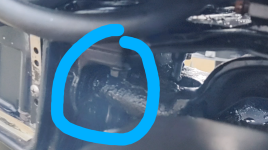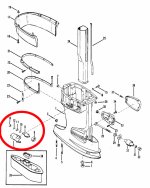Waverider17
Cadet
- Joined
- Feb 7, 2023
- Messages
- 9
Hi,
I appear to have an exhaust leak coming from the back of my outboard towards the transom bracket. I only found it because I noticed a small splattering of oil in the splash well and then noticed exhaust water dripping down the back of the leg. I've attached a photo of where the leak is coming from and was wondering what the cause of this could be, and if it's safe for light use while I search and wait for parts? The pee stream is normal and no other symptoms, I probably wouldn't have noticed for the rest of the season if I hadn't been cleaning the boat
I appear to have an exhaust leak coming from the back of my outboard towards the transom bracket. I only found it because I noticed a small splattering of oil in the splash well and then noticed exhaust water dripping down the back of the leg. I've attached a photo of where the leak is coming from and was wondering what the cause of this could be, and if it's safe for light use while I search and wait for parts? The pee stream is normal and no other symptoms, I probably wouldn't have noticed for the rest of the season if I hadn't been cleaning the boat






















